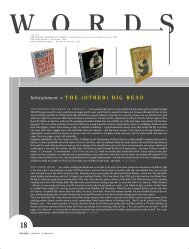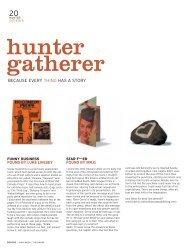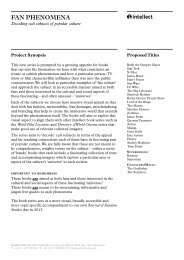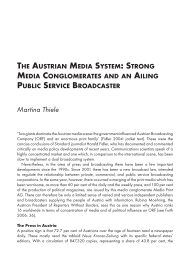Anthem - Intellect
Anthem - Intellect
Anthem - Intellect
You also want an ePaper? Increase the reach of your titles
YUMPU automatically turns print PDFs into web optimized ePapers that Google loves.
Signifying Europe<br />
Beethoven’s music is obviously an eminently open text, full of ‘unconsummated<br />
symbols’ says Cook, borrowing a term from Susanne Langer. He shows how this<br />
has tempted different listeners to interpret the Ninth in highly contradictory ways,<br />
letting it support universal peace, western democracy, Nazi rule or even Chinese<br />
communism. 384 Cook instead follows Theodor W. Adorno by stressing the inner<br />
contradictions in this music: ‘its lack of organic unity, its fragmentary quality, its<br />
ultimate refusal to make sense’. 385 ‘The work that symbolizes the pursuit of wealth<br />
in Hong Kong and communist orthodoxy in the People’s Republic, that stands for<br />
Western democracy and forms part of Japan’s social fabric—how can such a work<br />
be said to mean anything at all?’ 386 This work is ‘profoundly ambivalent’: the music<br />
deconstructing Schiller’s lyrics which in turn deconstructs itself, as the Turkish march<br />
clashes with lines such as ‘And the seraph stands with God’. 387 Cook believes that<br />
Beethoven here detached himself from his own affirmative message. 388<br />
Beethoven’s last symphony proclaims the ideals of universal<br />
brotherhood and joy; that is unmistakable. But at the same time,<br />
and just as unmistakably, it casts doubt upon them. It sends out<br />
incompatible messages. And that is why, like Parsifal, the Ninth<br />
Symphony has the capacity to resist being wholly assimilated within<br />
any single, definitive interpretation; however it is interpreted, there is<br />
always a remainder that lies beyond interpretation. But this resistance<br />
can only be effective it we remain conscious of the incongruities, the<br />
incoherence, the negative qualities of the music. 389<br />
In spite of this, Cook does not at all abandon interpretation but on the contrary argues<br />
for the need for continued reinterpretation, as ‘the only way to prevent the Ninth<br />
Symphony from being consumed by ideology’. 390<br />
The most scandalous obstacle to any straightforward interpretation of the symphony<br />
lies in how the ‘Turkish’ march music is positioned in the overall design of the work. As<br />
Cook has shown, it has been perceived as an ‘outrageously foreign element’. It had since<br />
the late eighteenth century been common to play with ‘alla Turca’ elements in classical<br />
music, inserting exotic touches of rough marching rhythms and instrumentation of<br />
percussion and wind, inspired by the military march music of the Ottoman Empire’s<br />
janissaries, which had existed since at least the fourteenth century and had a growing<br />
influence on Europe, as part of an Orientalising vogue for Turkish culture. These<br />
military bands originally had the function to make maximal frightening noise so as<br />
to rouse respect when Turkish troops came marching in. When tamed by classical<br />
composers, with Mozart’s piano sonata no. 11 in A-major K. 331 (c. 1783) as the most<br />
famous example, the style was reduced to an exotic spice signifying a combination of<br />
popular and Oriental roughness and rage.<br />
168












